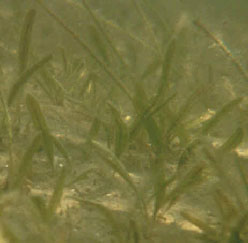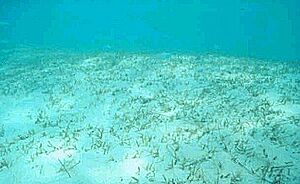Johnson's seagrass facts for kids
Quick facts for kids Johnson's seagrass |
|
|---|---|
 |
|
| Closeup of a bed of Johnson's seagrass | |
| Conservation status | |
| Scientific classification | |
| Kingdom: | |
| (unranked): | |
| (unranked): | |
| Order: | |
| Family: |
Hydrocharitaceae
|
| Genus: |
Halophila
|
| Species: |
H. johnsonii
|
| Binomial name | |
| Halophila johnsonii Eiseman and McMillan
|
|
Johnson's seagrass, also known as Halophila johnsonii, is a very small and special type of seagrass. It belongs to the plant family Hydrocharitaceae, which are often called "tape-grasses." This unique plant grows only along the southeastern coast of Florida.
It holds a special place in history because it was the first marine plant ever listed on the United States endangered species list. It is currently listed as a threatened species, meaning it needs protection to survive.
Contents
Johnson's Seagrass: A Special Plant
Johnson's seagrass is quite unusual because it mostly reproduces without seeds. Scientists have seen female flowers, but even after many years of watching, they have never found male flowers or seeds. This means it usually spreads in other ways, like by growing new shoots from its roots.
Where Does It Live?
This seagrass has one of the smallest living areas of all seagrasses. It can only be found in lagoons along about 200 kilometers (125 miles) of Florida's coastline. This area stretches between Sebastian Inlet and the northern part of Biscayne Bay.
It grows in small patches, from just a few centimeters to several meters wide. You can find it in shallow waters, from the areas that are sometimes exposed at low tide down to about 3 meters (10 feet) deep.
What Does It Look Like?
Johnson's seagrass is a tiny plant. It has pairs of long, thin leaves that grow from a stem called a rhizome. This rhizome creeps along just below the sand or mud surface. It has roots that help anchor the plant to the bottom.
The leaves are usually 2 to 5 centimeters (about 1 to 2 inches) long. The parts of the rhizome between the leaf pairs are also short, usually 3 to 5 centimeters long. Because of its small size, it looks much smaller compared to other types of seagrass.
Who Eats It?
Some animals in the ocean like to munch on Johnson's seagrass. The Green sea turtle and the West Indian manatee are known to feed on this plant. Some herbivorous (plant-eating) fish also enjoy it as a snack.
What Are the Threats?
Even though some animals eat it, the biggest danger to Johnson's seagrass comes from human activities. Many things we do can harm this special plant:
- Eutrophication: This happens when too many nutrients, often from pollution, get into the water. It can cause too much algae to grow, blocking sunlight and harming the seagrass.
- Dredging: This is when people dig up the bottom of the ocean or a waterway, often to make channels deeper. This can destroy seagrass beds directly.
- Turbidity: This means the water is cloudy or murky. When the water is not clear, sunlight can't reach the seagrass, which it needs to grow.
- Thermal pollution: This is when water that is too hot, often from power plants, is released into the ocean. This can make the water too warm for the seagrass to survive.
Protecting Johnson's seagrass is important because it's a unique part of Florida's marine environment and plays a role in its ecosystem.



